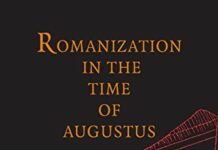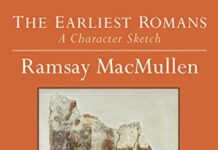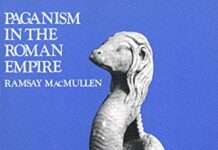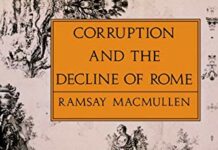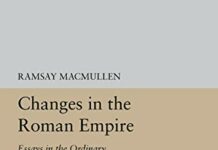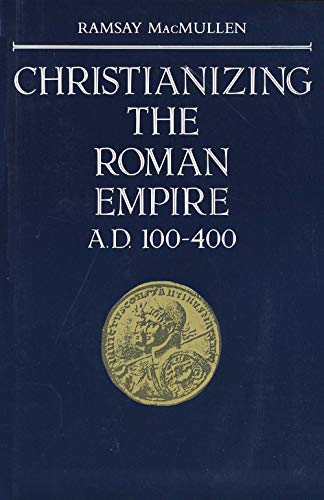
Ebook Info
- Published: 1984
- Number of pages: 184 pages
- Format: PDF
- File Size: 8.47 MB
- Authors: Ramsay MacMullen
Description
How did the early Christian church manage to win its dominant place in the Roman world? In his newest book, an eminent historian of ancient Rome examines this question from a secular―rather than an ecclesiastical―viewpoint. MacMullen’s provocative conclusion is that mass conversions to Christianity were based more on the appeal of miracle or the opportunity for worldly advantages than simply on a “rising tide of Christian piety.”“Provocative to the Christian religious scholar and the nonreligious historian alike. . . . MacMullen’s style is lucid, and the story of a period with its own innate interest is narrated with compelling feeling. . . . It is an important book, and highly recommended for the general reader of history as well as the Christian who wonders how the ‘Jesus movement’ came, by Constantine’s time, to be the church we know―Choice“Written in a fresh and vigorous style, . . . [this book] offers an admirable survey of some major aspects of the history [of the early Christian church].”―Robert M. Grant, New York Times Book Review “Gently provocative. . . . MacMullen has written an instructive and enjoyable book on a great theme.”―Henry Chadwick, Times Literary Supplement “A carefully argued and well-written study.”―Jackson P. Hershbell, Library Journal
User’s Reviews
Editorial Reviews: From the Back Cover How did the early Christian church manage to win its dominant place in the Roman world? In his newest book, an eminent historian of ancient Rome examines this question from a secular-rather than an ecclesiastical-viewpoint. MacMullen’s provocative conclusion is that mass conversions to Christianity were based more on the appeal of miracle or the opportunity for worldly advantages then simply on a ‘rising tide of Christian piety.’
Reviews from Amazon users which were colected at the time this book was published on the website:
⭐Ramsay MacMullen, the author of Christianizing the Roman Empire, is the Dunham Professor of History and Classics at Yale University. On January 5, of 2001 he was the recipient of a lifetime Award for Scholarly Distinction from the American Historical Association. The citation begins, “Ramsay MacMullen is the greatest historian of the Roman Empire alive today.” Obviously the author is eminently qualified for his research for this work. Christianity grew dramatically from the day of Pentecost to the year 400 through mass conversations. At the end of the first century, the church held a minimal significance in Roman society. It simply “did not count.” Within three centuries it included ten percent of the population and had displaced the other religions of the empire. In Christianizing the Roman Empire MacMullen addresses the factors for this amazing growth. The author demonstrates that these mass conversions first came through the power of miracles and later through the social advantage of becoming a Christian. As such, MacMullen is diminishing the value of Christian piety and the testimony of martyrs as reasons for the mass evangelization. The book is divided into two sections, which are the times prior to 312 and after 312 (Constantine’s “conversion” in 312 and the Edict of Milan in 313). He first examines what Pagans of the culture believed. Then he looks at what Christians presented to the Pagans about this new faith, and how they presented it. The influence of Constantine is examined, as are the non-religious factors that led to conversions. MacMullen then looks at evangelical campaigns after 312, including the conversion of intellectuals. Finally he looks at the quality of the conversions and those that were won through coercion.I found MacMullen’s research and use of sources of the highest quality. The book contains forty-three pages of endnotes and commentary by the author about the endnotes. In addition, the biography is extensive and would be of great value for those desiring to do additional research on the subject. He uses many sources to verify his thesis that Christian miracles during the early years and favored advantage in the former years, rather than Christian love, piety, and courage in martyrdom, resulted in the dramatic growth of the church. MacMullen’s research confirmed that Christianity becoming the Roman State religion strongly diluted the spiritual nature of the church.Christianizing the Roman Empire is an outstanding work of research by an eminently qualified authority. I found the material fascinating. Some of it attacked my pre-conceived notions, while other aspects of the book confirmed my reasoned suspicions. The book is written for those who already have some knowledge and study in church history during this era in Rome. Though MacMullen obviously is writing this book to an educated audience, the writing style is not nearly as high quality as his research. The first two chapters may cause some sincere readers to give up on the book before they have an opportunity to enjoy its valuable contribution. Despite its shortcomings, I would highly recommend Christianizing the Roman Empire to those with a high interest in learning more about this period of Roman and church history.
⭐Ramsey MacMullen has much to offer contemporary scholarship on the much-discussed and always open-ended problem of Christianization in the Roman Empire. MacMullen systematically renders an insightful overview of the different transitions in the process of Christianization as follows: first the period from New Testament evangelism (as found in the Epistles and the Acts) to Constantine’s conversion, and the period following after the emperor’s conversion all the way to AD 407. MacMullen does not discount the more customary viewpoints held by scholars such as Edward Gibbon and J.B. Bury, or, for that matter, traditional ecclesiastical interpretation as well; he does add to them though; and this is his most remarkable feat. He manages to maintain a balance between the secular and the ecclesiastical, in turn offering food-for-thought for all readers. Ramsey MacMullen’s work deserves praise and possible precedence even over the renowned scholar Peter Brown’s works, which bear a similarity to R.M.’s but lack the same objectivity. While his style of prose is a bit unseasonable and skewed at times, the work, overall, will undoubtedly come as a relief and reward to anyone yet to be familiar with it.
⭐However style of the author – how he describes his view on maters of history – is unusual one, I found this book very important. I really apriciate the courage way how author wrote about hard issues. As well author didn’t avoid very hard and contraversal questions, for example, expelling of demons, divine healing, miracles etc. As well author showed much examples from our-days phenomena that helps understand time the book is about. Thank you for this peace of truth!
⭐WHAT YOU’LL LEARN: In 100 AD Christianity was a minor cult, by 400 AD it was on it’s way to converting the vast empire. How? Well, convincing the Emperor (Constantine, 312 AD) and being able to kill people who disagreed helped. But earlier, between 100 and 300, Christian miracle workers won converts. Martyrs were less common and less important than you’d think.MacMullen had devoted a 40 year career to ancient Rome around this time. Every conclusion he draws is based on original ancient sources.This book is based on non-Christian sources and looks at the early conversions as the ancient non-christians would have understood them. Highly recommended. And yes, it is hard to read.
⭐By reading this book, I learned a great deal about how the transformation of the Roman Empire from a pagan to a Christian culture took place. If a reader has this objective in mind it should be highly recommended. However, it isn’t very entertaining so don’t expect it to be. Assume you are in college and you are reading it for information to put in a term paper and you won’t be disappointed.
⭐This book very effectively goes through the historical inaccuracies most people are confronted with when discussing martyrdom in the roman empire and how the shift from a pagan society to a christian society occurred, as well as how the christians acted once they weren’t the “persecuted” people anymore.
⭐MacMullen adds the important observation that the ferocity of Christians towards non-Christians tends to be given little notice in accounts of the early church. The examples he adduces precede the conversion of Constantine only by a little while, so one may conclude that it was the sheer growth of the church, rather than its endorsement by the state, that began to corrupt it.
⭐This is a very short book on a very large topic. The scholarship is astounding, though evidence for this is wisely confined to the (extensive) notes section. MacMullen commands an unrivalled knowledge of the evidence surviving from early Christian times, from documents of course, but also from inscriptions and archaeological remains. He puts an amazingly cool and at times imaginative historian’s brain to work to make sense of all this evidence, coming to conclusions that are no doubt challengeable (as is the way of all science) but which seem to me to be fairly robust. To arrive at these from a survey of fragmented but extensive evidence is an intellectual achievement on a par with, well, I would say Quantum Physics.From the New Testament and related documents we have some idea of how the very first Christian, or at least Pauline, communities functioned as household based, urban “assemblies”. For the second century we know something went on about the formation of the role of “bishop” but we don’t really know the process and how it interacted with the processes that later led to a so-called “orthodoxy”. MacMullen reckons that there was a conversion rate of about half a million a generation over the second century, ending up with about 5 million “Christians” of one type or another (he is wise not to be more specific) by the time of Constantine’s conversion. This was about 20% of the Empire’s population. This might compare to similar conversions to other cults and may have involved comings and goings to “Christianity” but it quite remarkable nonetheless. He argues convincingly that these conversions took place largely at the domestic or local level, based on conversions of heads of households, or their wives, and subsequently their families and entourages. Overwhelmingly the (Christian) documentation suggest that conversion was the result of witnessing or hearing about miraculous events or happenings performed by wandering holy men, often in contests with the “daimons” of pagan temples. (Mac Mullen thankfully acknowledges both the strength and the intellectual and moral respectability of pagan religion). In accepting the Christian religion, people did not have to accept anything strange to them, either in science, religion or morals, just an obviously more powerful “god”. The one new thing they had to come to terms with was the possibility of everlasting torment if they refused this obviously powerful Christ. This had an enormous effect.The unique feature of Christianity was its intolerance of other religions, which perhaps explains the (infrequent) persecutions. Once Constantine allowed toleration of Christians, they became more open in their attacks on temples and their “daimons”. They themselves attracted massive imperial donations and preference. There was a sort of “Dissolution of the Temples”, as Constantine and others raided the temple treasuries and, as time permitted, closed them down or put them to other uses. This process was long drawn out because of local opposition. Meanwhile, vast tracts of land in Italy and elsewhere – with all their tenants and slaves – became church property, with attendant “conversions” of all concerned. Imperial career paths could now be enhanced if you followed your master’s lead, and this had its effect all the way down to the local city level. Moreover, career paths in the Church now became lucrative, or at least had tax-exemption benefits, so much so that already in the third century there were frequent cases of corrupt and disputed appointments. The intolerance Christians showed to other cults they also showed to “Christians” with other ideas of what Christianity was (or to those who had been appointed to lucrative bishoprics they claimed for themselves).By the end of the fourth century possibly a bare majority of the Empire was “Christian” in some sense, but there was certainly a majority, though not a monopoly at the elite level and later in the army, so that Christians could become more aggressive in applying what they claimed to be “the law” often with great barbarity. Christians like Ambrose and Augustine really did think they were fighting “daimons” so we should not be surprised at the ferocity of their appeals and the actions they provoked. They had no problem with forced conversions either, many poor pagans being offered a choice of death or conversion. Nevertheless, it is hard for at least one 21st Century Christian to feel any co-religiosity with these people. As we enter the sixth century, the “Christian mob” begins to make regular appearances, especially in great centres of pagan civilisation, such as Alexandria. These mobs are often also turned upon “deviant” forms of Christianity (though extensive property rights in the enriched Church were also in play).Thus the church was established by word of mouth and local example, most often based on wandering miracle workers whose power persuaded people to choose an obviously more powerful, but very jealous, divine being over all the defeated “daimons”. This was backed up (for the same reason) by imperial preference, money and an increasingly aggressive often very violent application of a “legal” demand for uniformity of belief and for the destruction of “daimons”. It is an amazing story, but it leaves me at a loss to think what the Holy Spirit was up to during this (and, let’s be honest, all later times). Perhaps the Reformers were right, and the whole Imperial Church was a sham, or at best an edifice within which real Christians could continue to lead out their lives quietly. Perhaps the Holy Spirit really does just choose specific individuals in any generation to be part of the “Church” no matter what institutions are put in place or “orthodoxy” enforced by the Princes and the Powers.I have one reservation about the book and that is MacMullen’s almost too casual writing style – allusive, almost ironical and often a bit involuted – which sometimes makes it difficult to work out exactly what he is claiming. The overall argument is clear and convincing, though, based on scholarship of the highest standard.
⭐Very scholarly but lots of great information on the progress of Christianity in the second and third century.
⭐I’m an historian who is interested in the early history of Christianity. I have read Wilken and Stark, as well as Chadwick and discussions about the Gospels and early Christian writings.I had not expected Macmullen to be so anti-Christian in his writing to the extent that I think it let it affect his scholarly judgement. I am afraid that I found too many places where he sought to minimise the impact of Christianity on Roman society despite the evidence. In his favour is a wealth of material and scholarly references.I would recommend the book to Christians as a valuable discussion of the period, even though the conclusions should be viewed very sceptically.
Keywords
Free Download Christianizing the Roman Empire: A.D. 100-400 in PDF format
Christianizing the Roman Empire: A.D. 100-400 PDF Free Download
Download Christianizing the Roman Empire: A.D. 100-400 1984 PDF Free
Christianizing the Roman Empire: A.D. 100-400 1984 PDF Free Download
Download Christianizing the Roman Empire: A.D. 100-400 PDF
Free Download Ebook Christianizing the Roman Empire: A.D. 100-400
